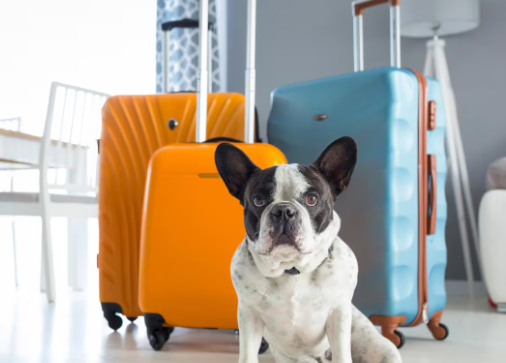How to Travel with a Dog: A Comprehensive Guide

Introduction to Traveling with a Dog
Traveling with a dog can be a delightful and rewarding experience. It allows you to share your adventures with your furry friend and creates a stronger bond between you and your pet. However, it also comes with its own set of challenges and considerations. This guide will walk you through everything you need to know to make your journey with your dog as smooth and enjoyable as possible. From preparation and packing to finding dog-friendly accommodations and ensuring safety, we’ve got you covered.
See also: What Documents Do I Need to Travel to Mexico by Car?
Preparing for the Journey
Before embarking on your trip, it’s crucial to ensure that your dog is healthy and ready for travel. Here are some steps to take:
- Vet Check-ups and Health Certificates: Schedule a vet visit to ensure your dog is in good health. Some destinations and modes of transport require a health certificate issued within 10 days of travel.
- Vaccinations and Medications: Make sure your dog is up to date on all vaccinations. If your pet is on any medication, ensure you have enough for the entire trip plus a few extra days.
- Microchipping and ID Tags: Ensure your dog’s microchip information is current and have a sturdy ID tag with your contact information. This is vital in case your dog gets lost during your travels.
Choosing the Right Mode of Transportation
Deciding on the best mode of transport depends on various factors, such as distance, destination, and your dog’s comfort level. Each option comes with its own set of pros and cons:
- Traveling by Car: Ideal for short to medium distances and offers the flexibility of stops. It’s important to secure your dog with a seat belt harness or a crate for safety.
- Traveling by Plane: Requires careful planning and adherence to airline regulations. Not all airlines are pet-friendly, and some only allow dogs in the cabin if they are small enough to fit under the seat.
- Traveling by Train or Bus: Rules vary greatly by company and country. Some trains in Europe are very dog-friendly, while others might not allow pets at all.
Road Trips with Your Dog
Road trips are often the most enjoyable way to travel with your dog, offering freedom and flexibility. Here’s how to make your road trip a success:
- Preparing Your Car for Your Dog: Ensure your car is pet-friendly with seat covers and a crate or harness for your dog’s safety. Bring a sunshade for hot days to keep your dog cool.
- Dog-Friendly Road Stops: Plan your route to include regular stops at pet-friendly rest areas. This allows your dog to stretch, relieve themselves, and stay hydrated.
- Safety Tips for Dogs in Cars: Never leave your dog alone in a parked car, especially in warm weather. Use seat belts or carriers to keep them secure and avoid distractions while driving.
Air Travel with Your Dog
Flying with your dog can be challenging but manageable with the right preparation. Here’s what you need to know:
- Understanding Airline Policies: Every airline has different policies regarding pet travel. Some allow small dogs in the cabin, while others only allow pets in the cargo hold. Make sure to read and understand these policies well in advance.
- Crate Training for Air Travel: If your dog is flying in the cargo hold, a sturdy, well-ventilated crate is essential. Begin crate training weeks or months before your trip to ensure your dog is comfortable.
- Booking a Pet-Friendly Flight: Choose direct flights to minimize the stress of take-offs and landings. Avoid flying during extreme weather conditions that could affect your dog’s well-being.
Packing Essentials for Your Dog
When packing for your dog, it’s important to consider both comfort and safety:
- Food and Water Supplies: Pack enough of your dog’s regular food to last the entire trip, as well as a portable water bowl and bottled water to ensure hydration.
- Comfort Items: Bring along your dog’s favorite toys, blankets, or bed to provide a sense of familiarity and comfort in new environments.
- First Aid Kit for Dogs: Include basic first aid supplies like bandages, antiseptic wipes, and any medications your dog may need. Having a first aid kit is crucial for addressing minor injuries or health issues on the go.
Finding Dog-Friendly Accommodations
Not all accommodations welcome pets, so it’s important to do your research ahead of time:
- Hotels and Motels: Many hotels and motels are pet-friendly, but policies vary widely. Some may charge extra fees or have restrictions on the size or breed of dogs allowed.
- Pet-Friendly Airbnb and Vacation Rentals: Platforms like Airbnb offer filters to help you find pet-friendly rentals. These often provide more space and comfort for your dog compared to a traditional hotel.
- Campgrounds and RV Parks: If you enjoy outdoor adventures, many campgrounds and RV parks are dog-friendly. Make sure to check their specific rules regarding pets.
Ensuring Your Dog’s Comfort During Travel
Travel can be stressful for dogs, especially if they are not accustomed to it. Here are some tips to help your dog stay calm:
- Recognizing Stress and Anxiety in Dogs: Look for signs of stress such as excessive panting, whining, or pacing. Understanding these signs will help you take appropriate action.
- Tips for Calming an Anxious Dog: Use calming aids like pheromone sprays, anxiety wraps, or natural supplements. Regular breaks and exercise also help reduce anxiety.
- Regular Exercise and Breaks: Ensure your dog gets plenty of exercise before and during the trip to help burn off excess energy and reduce stress.
Travel Safety Tips for Dogs
Safety should be a top priority when traveling with your dog:
- Using Seat Belts and Crates: Seat belts and crates are essential for keeping your dog safe in a moving vehicle. They also prevent your dog from becoming a distraction to the driver.
- Avoiding Extreme Temperatures: Never leave your dog alone in a vehicle, especially in hot or cold weather. Extreme temperatures can be dangerous and even fatal.
- Hydration and Feeding Schedules: Keep your dog hydrated, especially in hot weather or if they are panting heavily. Plan feeding times to avoid motion sickness during travel.
Exploring New Places with Your Dog
Exploring new places with your dog can be a great experience, but it requires some planning:
- Finding Dog-Friendly Attractions: Research parks, trails, beaches, and other attractions that welcome dogs. Many cities also have dog-friendly tours and events.
- Handling Crowds and Public Spaces: Keep your dog on a leash in crowded areas and be mindful of their behavior around strangers and other animals.
- Off-Leash Areas and Parks: Look for designated off-leash areas where your dog can run and play freely. Make sure your dog is well-behaved and follows commands when off-leash.
Managing Health and Safety During Travel
Keeping your dog healthy during travel is crucial:
- Preventing Motion Sickness: Gradually acclimate your dog to traveling and avoid feeding them right before departure to reduce the risk of motion sickness.
- Managing Allergies and Insect Bites: Carry any necessary medications or treatments for allergies and insect bites. Familiarize yourself with local flora and fauna to avoid harmful encounters.
- Emergency Veterinary Services: Research veterinary services at your destination and along your route. Having this information readily available can save precious time in case of an emergency.
International Travel with Your Dog
Traveling internationally with a dog requires additional planning and preparation:
- Understanding Pet Passport Requirements: Many countries require a pet passport, which includes proof of vaccinations and other health records.
- Customs and Quarantine Procedures: Some countries have strict quarantine laws. Research and plan for any quarantine periods that may be required upon arrival.
- Cultural Differences in Pet Regulations: Different cultures have different attitudes and laws regarding pets. Research these before you go to avoid any misunderstandings.
Legal Considerations When Traveling with Dogs
Understanding local laws and regulations is important to avoid legal trouble:
- Understanding Local Laws: Research local leash laws, breed restrictions, and other pet-related regulations in your destination.
- Breed-Specific Regulations: Some regions have restrictions on certain breeds. Ensure your dog is allowed in your destination to avoid any issues.
- Liability and Insurance: Consider pet insurance that covers travel and look into liability insurance in case your dog causes damage or injury.
FAQs on Traveling with Dogs
How do I prepare my dog for a long flight?
Prepare your dog for a long flight by crate training, ensuring they are comfortable, and booking a direct flight if possible.
What should I do if my dog gets anxious during travel?
Use calming aids, provide regular breaks, and offer comfort items to help reduce anxiety.
Are there any special documents required for international travel with a dog?
Yes, most countries require a pet passport, health certificate, and proof of vaccinations.
Can I bring my dog on public transportation?
Rules vary by country and transportation type; some allow pets while others do not.
What are the best ways to keep my dog safe in a car?
Use a seat belt harness or crate, keep them hydrated, and never leave them alone in the car.
How do I find dog-friendly accommodations?
Use travel websites with pet-friendly filters and read reviews from other pet owners.
Conclusion
Traveling with a dog can be a wonderful adventure filled with memorable moments. With proper planning, preparation, and consideration for your dog’s needs, you can ensure a safe, enjoyable, and stress-free trip. Whether you’re hitting the road, flying across the globe, or exploring a new city, your furry companion can be a great travel buddy.




